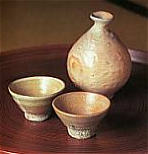|
  Sake and Temperature Sake and Temperature
At what temperature should you enjoy sake?
As with all things sake-related, there is a long answer and short answer.
Short Answer: Most good sake should be enjoyed slightly chilled. Cheaper sake is served warm.
Long Answer: Indeed, sake was traditionally served warmed. This was related to the fact that sake was, until about 30 or 40 years ago, much, much rougher, fuller, sweeter and woodier than it is
now. Warming suited it much better back then.
Wooden (cedar) tanks were used for brewing for centuries, slowly being phased out in
the early part of the 20th century. Also, before glass bottles, for centuries sake was then stored in wooden casks (also cedar). As such, they took on a tremendously woody flavor
and aroma. While this might have been enjoyable, today's fine fragrances and subtle flavors would be bludgeoned out of existence by such wood (although you can still enjoy
such sake today; it is called "taru-zake").
But in the end, one big reason sake was warmed in the old days was that it was woodier
and rougher, and warming masked a lot of the less-than-refined aspects.
However, about 30 to 40 years ago, things began to change in the sake-brewing world.
Brewing technology and the availability of new strains of sake rice (and the equipment to properly handle it) and new pure yeast strains led to sake with bold and lively taste and
fragrance profiles. Much more delicate and fragile sake also came about, with fruit and flowery essences all of a sudden becoming part of the equation. Sake like this would be
effectively neutered of the very qualities it was brewed to exude, if heated. Today, sake is brewed in stainless steel, ceramic-lined tanks, and stored in bottles. Rice milling
technology is immeasurably better than it was even just 30 or 40 years ago. Most premium sake today is delicate, fragrant, and elegant. To heat such sake would be to
destroy precisely the flavors and fragrances the brewer worked so hard to have you enjoy!
So: Most good sake should be enjoyed slightly chilled. How chilled? The short answer: like white wine or even a little warmer. Much sake peaks in flavor just below room
temperature. The long answer: like wine and any other premium beverage, each sake will be different at even slightly different temperatures. Every sake will appeal to some
people at one temperature, and other people at another temperature. What appeals to you most is the best temperature for that sake, for you, on that day.
Sake should never be served too cold. When sake is over-chilled you cannot taste anything. Sure, flaws would be covered up, but so would more refined aspects of the
sake, as nothing is discernible. If someone tells you to enjoy sake ice cold, it is because they know their sake is inferior. To propagate such an untruth is unethical and unfair to brewers of fine sake.
But wait! It is not all that simple! The long answer continues.The truth is, there is plenty
of good sake, premium ginjo and sometimes daiginjo even, that goes quite well when gently warmed. (But never too hot!) Plenty indeed. It is too easy, in this era of chilled
premium ginjo sake, to overlook how fine warm sake can be, especially in the winter.
So, how do you know whether to warm a sake or to serve it chilled? How can you tell -
from the label or otherwise - if a sake will be good when warmed, or better chilled? Fortunately or unfortunately, it is purely a matter of personal preference.
Many sakagura (sake breweries) will tell you that a particular sake of theirs is especially tasty when warmed. Some list that information right on the label. Also, tasting a wide
variety of sake at a wide variety of temperatures will soon make it clear which flavor profiles appeal to you at warm temperatures and which do not. So, not surprisingly, the
more you taste, the more you will know. Recommendations of friends, restaurateurs, or shopkeepers can also can be useful in knowing which temperatures to serve a sake.
But in the end, you have to just taste a lot and figure it out for yourself.
|